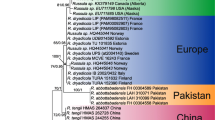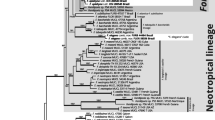Abstract
Beringia, including Alaska and North-Eastern Siberia, has long been a focal point for biogeographical research in a wide range of plant and animal taxa. Whether boreal forest refugia existed in Beringia during the Last Glacial Maximum (LGM) is a major but unanswered question in Quaternary science. We analysed DNA sequence data from Amanita muscaria using phylogenetic and coalescent methods to test whether this boreal-temperate ectomycorrhizal fungus was present in Alaska during the LGM. Our data indicates that there are at least two endemic groups showing no detectable migration from or to populations that survived the LGM in Southern refugia. One of these occurs in the boreal forests of Interior Alaska, while the other group is endemic to the maritime rainforests from Southeast Alaska to the Olympic peninsula. These results suggest genetic isolation preceding the LGM and support the hypothesis of glacial forest refugia in Interior Alaska and along the coast of Southeast Alaska and British Columbia.
Access this chapter
Tax calculation will be finalised at checkout
Purchases are for personal use only
Similar content being viewed by others
References
Abbott RJ, Comes HP (2003) Evolution in the Arctic: a phylogeographic analysis of the circumarctic plant, Saxifraga oppositifolia (Purple saxifrage). New Phytol 161:211–224
Adams JM, Faure H (1997) Preliminary vegetation maps of the World since the last glacial maximum: An aid to archaeological understanding. J Archeol Sci 24:623–647
Alsos IG, Engelskjøn T, Gielly L, Taberlet P, Brochmann C (2005) Impact of ice ages on circumpolar molecular diversity: insights from an ecological key species. Mol Ecol 14:2739–2753
Anderson LL, Hu FS, Nelson DM, Petit RJ, Paige KN (2006) Ice-age endurance: DNA evidence for a white spruce refugium in Alaska. Proc Natl Acad Sci USA 103:12447–12450
Aylor D, Carbone I (2003) SNAP combine and map. Department of Plant Pathology, North Carolina State University, Raleigh, NC (http://www.cals.ncsu.edu/plantpath/faculty/carbone/home.html).
Bas C (1969) Morphology and subdivision of Amanita and a monograph of its section Lepidella. Persoonia 5:285–579
Beerli P, Felsenstein J (2001) Maximum-likelihood estimation of a migration matrix and effective population sizes in n subpopulations by using a coalescent approach. Proc Natl Acad Sci USA 98:4563–4568
Brubaker LB, Anderson PM, Edwards ME, Lozhkin AV (2005) Beringia as a glacial refugium for boreal trees and shrubs: new perspectives from mapped pollen data. J Biogeogr 32:833–848
Brunhoff C, Galbreath KE, Fedorov VB, Cook JA, Aarola M (2003) Holarctic phylogeography of the root vole (Microtus oeconomus): implications for late Quaternary biogeography of high latitudes. Mol Ecol 12:957–968
Budantsev LY (1992) Early stages of formation and dispersal of the temperate flora in the boreal region. Bot Rev 58:1–48
Carrarra PE, Ager TA, Baichtal JF, VanSistine DP (2003) Map of glacial limits and possible refugia in the Southern Alexander Archipelago, Alaska, during the late Wisconsin Glaciation, Miscellaneous Field Studies Map, MF-2424. US Geological Service, Denver, CO
Edwards ME, Anderson PM, Brubaker LB et al (2000) Pollen-based biomes for Beringia 18, 000, 6000 and 0 14C yr BP. J Biogeogr 27:521–554
Eidesen PB, Carlsen T, Molau U, Brochmann C (2007) Repeatedly out of Beringia: Cassiope tetragona embraces the Arctic. J Biogeogr 34:1559–1574
Elias SA, Berman D, Alfimov A (2000) Late Pleistocene beetle faunas of Beringia: where East met West. J Biogeogr 27:1349–1363
Fleming MA, Cook JA (2002) Phylogeography of endemic ermine (Mustela erminea) in Southeast Alaska. Mol Ecol 11:795–807
Geml J, Laursen GA, O’Neill K, Nusbaum HC, Taylor DL (2006) Beringian origins and cryptic speciation events in the Fly Agaric (Amanita muscaria). Mol Ecol 15:225–239
Geml J, Tulloss RE, Laursen GA, Sazanova NA, Taylor DL (2008) Evidence for strong inter- and intracontinental phylogeographic structure in Amanita muscaria, a wind-dispersed ectomycorrhizal basidiomycete. Mol Phylogenet Evol 48:694–701. doi:doi:10.1016/j.ympev.2008.04.029
Graham A (1999) Late cretaceous and cenozoic History of North American Vegetation. Oxford University Press, Oxford
Griffiths RC, Tavaré S (1994) Ancestral inference in population genetics. Stat Sci 9:307–319
Härkönen M, Saarimäki T, Mwasumbi L (1994) Tanzanian mushrooms and their uses 4. Some reddish edible and poisonous Amanita species. Karstenia 34:47–60
Hey J, Wakeley J (1997) A coalescent estimator of the population recombination rate. Genetics 145:833–846
Hultén E (1968) Flora of Alaska and neighboring territories. Stanford University Press, Stanford
Kaufman DS, Ager TA, Anderson NJ et al (2004) Holocene thermal maximum in the Western Arctic (0-180°W). Quat Sci Rev 23:529–560
Loehr J, Worley K, Grapputo A, Carey J, Veitch A, Coltman DW (2005) Evidence for cryptic glacial refugia from North American mountain sheep mitochondrial DNA. J Evol Biol 19:419–430
MacNeil D, Strobeck C (1987) Evolutionary relationships among colonies of Columbian ground squirrels as shown by mitochondrial DNA. Evolution 41:873–881
Markwordt J, Doshi R, Carbone I (2003) SNAP clade and matrix. Department of Plant Pathology, North Carolina State University, Raleigh, NC (http://www.cals.ncsu.edu/plantpath/faculty/carbone/home.html).
Maroja LS, Bogdanowicz SM, Wallin KF, Raffa KF, Harrison RG (2007) Phylogeography of spruce beetles (Dendroctonus rufipennis Kirby) (Curculionidae: Scolytinae) in North America. Mol Ecol 16:2560–2573
Nei M, Li WH (1979) Mathematical model for studying genetic variation in terms of restriction endonucleases. Proc Natl Acad Sci USA 76:5269–5273
Nielsen R, Wakeley J (2001) Distinguishing migration from isolation: a Markov chain Monte Carlo approach. Genetics 158:885–896
Oda T, Tanaka C, Tsuda M (2004) Molecular phylogeny and biogeography of the widely distributed Amanita species A. muscaria and A. pantherina. Mycol Res 108:885–896
Qian H (1999) Floristic analysis of vascular plant genera of North America North of Mexico: characteristics of phytogeography. J Biogeogr 26:1307–1321
Reiss AR, Ashworth AC, Schwert DP (1999) Molecular genetic evidence for the post-Pleistocene divergence of populations of the arctic-alpine ground beetle Amara alpina (Paykull) (Coleoptera: Carabidae). J Biogeogr 26:785–794
Simmons C, Henkel T, Bas C (2002) The genus Amanita in the Pakaraima mountains of Guyana. Persoonia 17:563–582
Smith SE, Read DJ (1997) Mycorrhizal symbiosis, 2nd edn. Academic, Cambridge
Sperling FH, Harrison RG (1994) Mitochondrial DNA variation within and between species of the Papilio machaon group of swallowtail butterflies. Evolution 48:408–422
Swanson DK (2003) A comparison of taiga flora in North-Eastern Russia and Alaska/Yukon. J Biogeogr 30:1109–1121
Thompson JD, Gibson TJ, Plewniak F, Jeanmougin F, Higgins DG (1997) The CLUSTAL X windows interface: flexible strategies for multiple sequence alignment aided by quality analysis tools. Nucleic Acids Res 25:4876–4882
Tremblay NO, Schoen DJ (1999) Molecular phylogeography of Dryas integrifolia: glacial refugia and postglacial recolonization. Mol Ecol 8:1187–1198
Weckworth BV, Talbot S, Sage GK, Person DK, Cook J (2005) A signal for independent coastal and continental histories among North American wolves. Mol Ecol 14:917–931
Wickström LM, Haukisalmi V, Varis S, Hantula J, Fedorov VB, Henttonen H (2003) Phylogeography of the circumpolar Paranoplocephala arctica species complex (Cestoda: Anoplocephalidae) parasitizing collared lemmings (Dicrostomyx spp.). Mol Ecol 12:3359–3371
Author information
Authors and Affiliations
Corresponding author
Editor information
Editors and Affiliations
Rights and permissions
Copyright information
© 2010 Springer-Verlag Berlin Heidelberg
About this paper
Cite this paper
Geml, J., Tulloss, R.E., Laursen, G.A., Sazanova, N.A., Taylor, D.L. (2010). Phylogeographic Analyses of a Boreal-Temperate Ectomycorrhizal Basidiomycete, Amanita Muscaria, Suggest Forest Refugia in Alaska During the Last Glacial Maximum. In: Habel, J.C., Assmann, T. (eds) Relict Species. Springer, Berlin, Heidelberg. https://doi.org/10.1007/978-3-540-92160-8_9
Download citation
DOI: https://doi.org/10.1007/978-3-540-92160-8_9
Published:
Publisher Name: Springer, Berlin, Heidelberg
Print ISBN: 978-3-540-92159-2
Online ISBN: 978-3-540-92160-8
eBook Packages: Biomedical and Life SciencesBiomedical and Life Sciences (R0)




